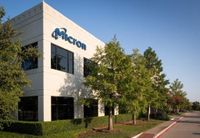In a significant move within the semiconductor industry, Micron Technology has set its sights on enhancing its high-bandwidth memory (HBM) market share, aiming for over 20% by the end of 2025. This ambitious goal comes on the heels of robust sales that reportedly saw Micron selling out its entire HBM inventory for 2025. The company expressed confidence in its trajectory during its Q2 2025 earnings call, revealing that it expects its HBM market share to align closely with its DRAM share by the fourth quarter of 2025.
Recent statistics show that Micron's DRAM market share increased to 22.2% in Q3 2024, marking a 2.6% rise from the previous quarter's 19.6%. However, competitors like Samsung Electronics and SK Hynix still hold substantial shares, with 41.1% and 34.4%, respectively, although both saw slight declines compared to earlier periods. Micron is also ramping up production capabilities for its HBM3E products, specifically the 8-layer and 12-layer versions that are set to support NVIDIA's AI semiconductors 'Grace Blackwell (GB) 200 and GB300'.
Utilizing its advanced manufacturing strategies, Micron aims to significantly increase production capacity and yield for HBM3E 12-layer products, projecting that these will constitute the bulk of its HBM shipments in the latter half of 2025. The company is also engaging with clients to discuss what they anticipate will be a strong demand for HBM products into 2026. Looking ahead, Micron plans to initiate mass production of its next-generation HBM4 in 2026, which promises over 60% improved bandwidth compared to its predecessor, HBM3E.
To back up these advancements, Micron is leveraging support from the U.S. Chips Act, which aims to bolster domestic semiconductor production. Earlier this year, Micron announced a substantial investment of approximately $70 billion in a new, dedicated HBM advanced packaging plant located in Singapore's Woodland region. This facility is expected to supply HBM products to major tech companies including NVIDIA and Broadcom.
Additionally, Micron is preparing to launch HBM production at its Hiroshima factory in Japan by 2027. However, industry experts express skepticism regarding Micron's ability to achieve the 20% HBM market share within the projected timeframe, pointing out that its scale in TSV process production capacity still lags behind that of its rivals, like SK Hynix and Samsung.
Concurrently, on March 21, 2025, stock markets across the U.S. faced challenges as the three major indices struggled to break free from a downward trend. The Dow Jones Industrial Average saw a slight decrease of 44 points (0.11%) to settle at 41,908. The S&P 500 and Nasdaq Composite indices also experienced drops of 11 points (0.20%) and 7 points (0.04%), respectively, indicating a general reluctance among investors to commit amidst economic uncertainty.
Prominent companies showed a spectrum of performance; while Tesla surged by 4.4%, Netflix rose by 0.7%, Palantir climbed by 3.1%, and ARM edged up by 0.1%, technology titans like NVIDIA, Microsoft, and AMD saw their stocks decrease by 0.9%, 0.2%, and 0.2% respectively. In particular, Micron Technology's shares plummeted by over 8% despite announcing a healthy earnings report driven by the sale of AI memory chips, indicating that investor sentiment may have been dampened by its lower-than-expected profit margins.
Micron's Q2 2025 revenue, standing at $10 billion with a year-over-year increase of 38%, did not manage to satisfy market expectations concerning profit margins. Analysts had anticipated an adjusted earnings margin of 38.4%, yet Micron reported only a 37.9% margin, with projections for the current quarter expected to dip further to 36.5%.
This financial backdrop coincides with ongoing developments in broader geopolitical and economic contexts. Recent comments from President Trump regarding tariffs outlined a reassertion of his administration's stance on trade and economic policies. Calling April 2, 2025, the 'Day of American Liberation' on social media, Trump remarked on the perceived injustices faced by the U.S. in international trade, emphasizing his administration's commitment to levying tariffs universally.
The broader implications of these tariff policies are also impacting corporate behavior, as firms respond to heightened uncertainty around tariff impositions and economic conditions. Simplifly Asset Management strategist Michael Green remarked, "Tariff concerns are burdening companies, which are delaying decisions on business plans, capital expenditures, and new hires due to a growing climate of uncertainty. These worries inevitably reflect in the market outcomes we’re seeing today."
As U.S. Treasury yields show mixed results, particularly with the 10-year yield climbing to 4.250% and 2-year yield declining to 3.946%, investors continue to grapple with the implications of such fluctuations on market conditions. Furthermore, with mixed signals on interest rates from Federal Reserve officials, market players remain watchful in anticipation of guidance on future monetary policy.
With the S&P 500 and Nasdaq indices now contending with five consecutive weeks of declines, and the Nasdaq nearing correction territory, it is clear that the interplay between the semiconductor sector and broader economic currents will continue to shape market dynamics in the months ahead. Investors are left to assess the potential implications of Micron's ambitious objectives, tariff discussions, and shifting investor sentiment as they navigate through a highly complex financial landscape.

![[속보]미국증시, 마이크론 급락+상호관세에 반도체 약세 나스닥-다우-S&P 동반 하락](https://thumbor.evrimagaci.org/akl6bpDLl3lzj0RsIsPAwNpZmwI=/200x0/tpg%2Fsources%2F12cfe297-916e-4435-b972-d727e17ac821.jpeg)



